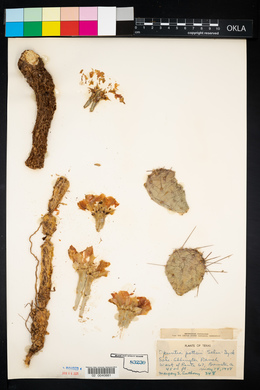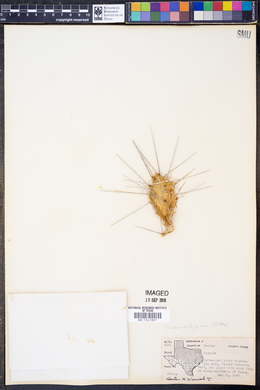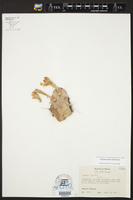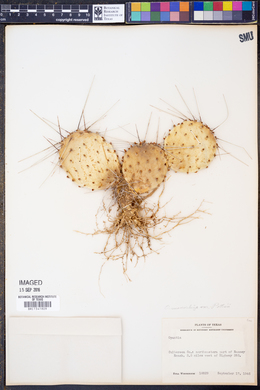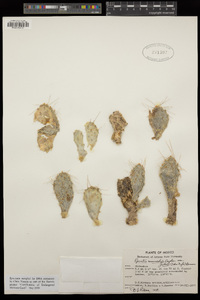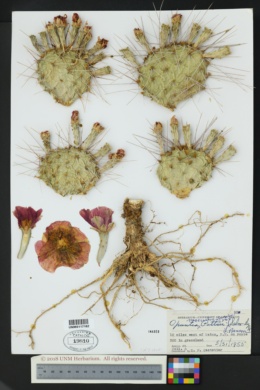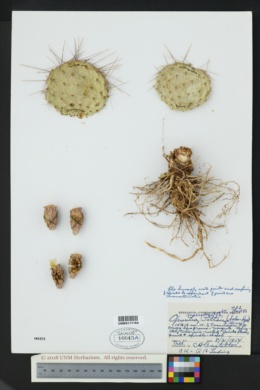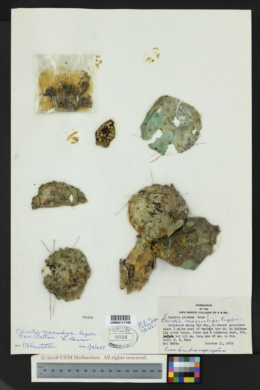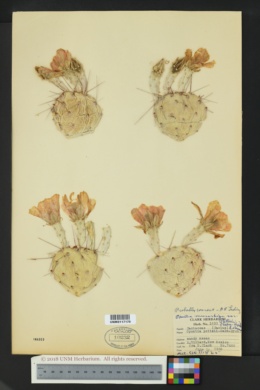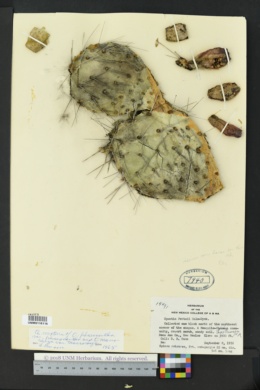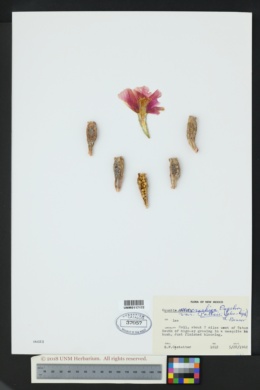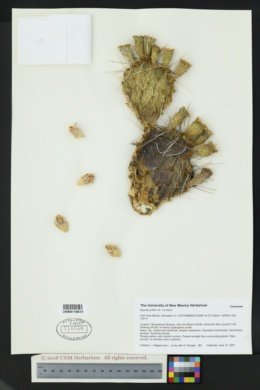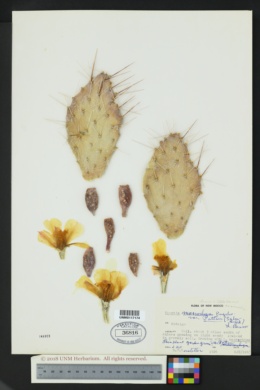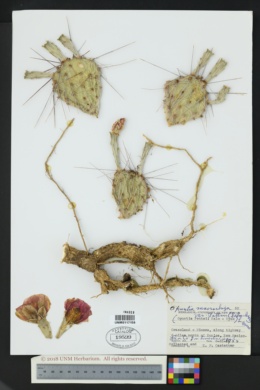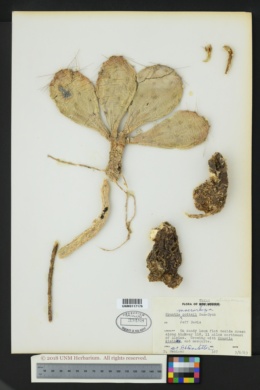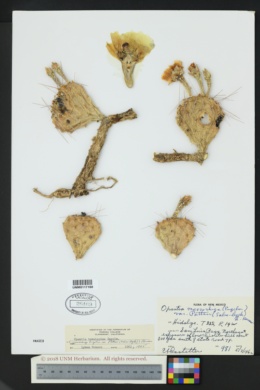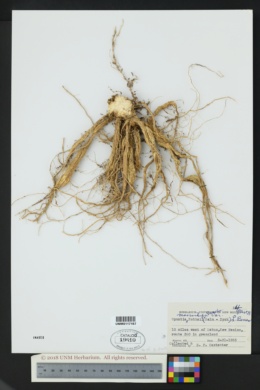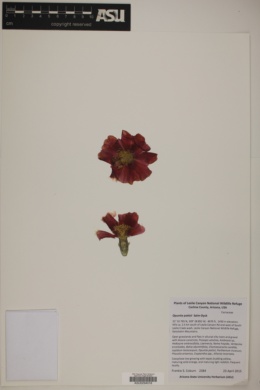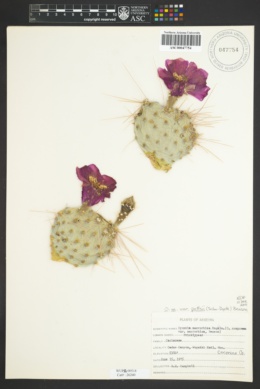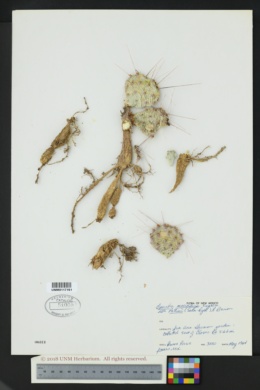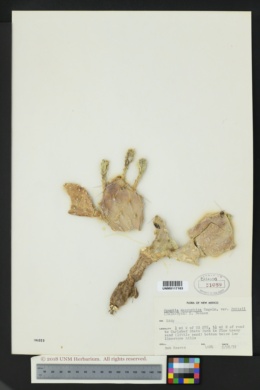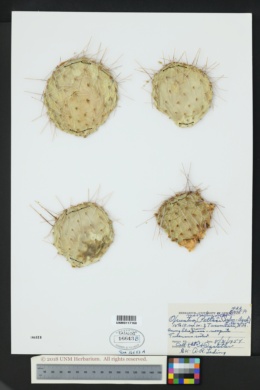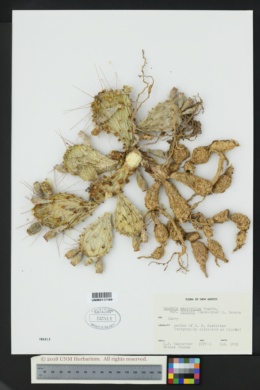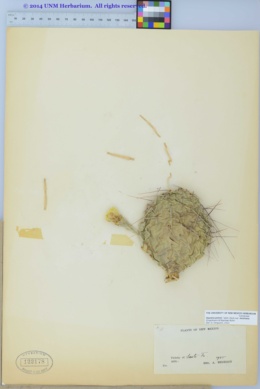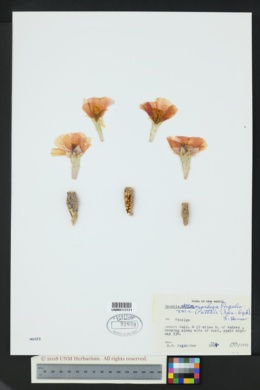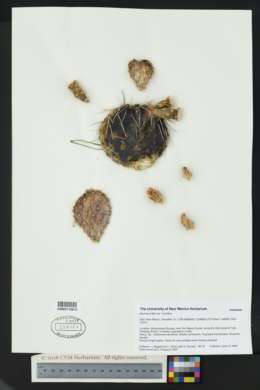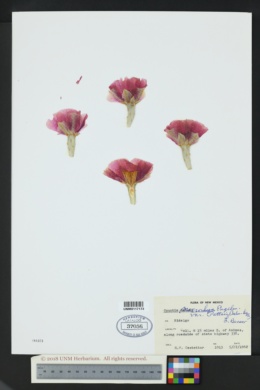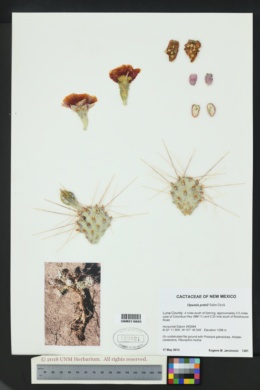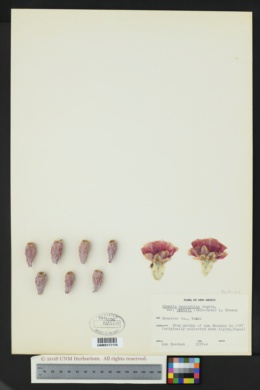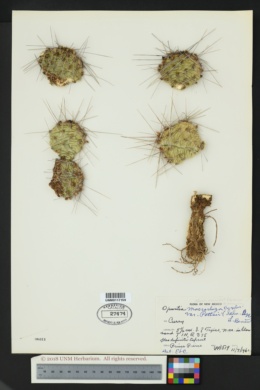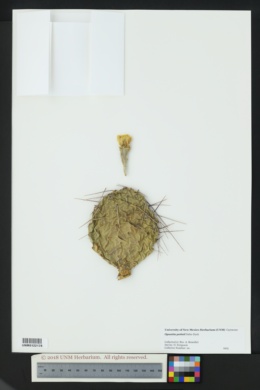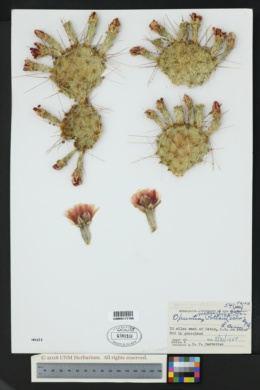Opuntia pottsii
|
|
|
|
Family: Cactaceae
Pott's Prickly-Pear, more...twistspine pricklypear
[Opuntia macrorhiza var. pottsii (Salm-Dyck) L. Benson] |
PLANT: Clump-formers, to 35 cm tall, often from tuber-like rootstocks. PADS: green, glabrous, usually glaucous, fleshy, not disarticulating, cuneate-obovate to commonly rhombic, 5-20 cm long, 4-8 cm broad. AREOLES: 5-7(-8) in diagonal row across mid-pad, oval to subcircular, 2-4 mm in diameter; wool tan. SPINES: mostly in distal 40% of pad, gray-white to red-brown, erect or reflexed, (0-)1-6 per areole, straight, slender (0.25 mm diam. near base), flexible, terete or lower ones flattened, the largest 2-6 cm long. GLOCHIDS: yellowish, tan to red-brown, aging brown, in dense apical tuft, to 6 mm long. FLOWERS: inner tepals ± red to rose; filaments pale yellow, style white; fresh stigmas yellow. FRUITS: green to yellowish, fleshy, elongate-obovoid, long-stipitate, spineless, 2.5-4 cm long, 1.5-2.8 cm in diameter; areoles 12-26. SEEDS: tan, subcircular, 4-5 mm in diameter, thickish, warped; girdle broad, protruding to 0.5 mm. 2n = 44. NOTES: Sandy to loamy soils of grassy plains and hills; Cochise, Pinal cos.; 900-1850 m (2900-6000 ft.); May-Jul; NM, TX; Mex.: Chih. Hybridizes with Opuntia macrorhiza in se AZ. REFERENCES: Pinkava, Donald J. 2003. Cactaceae. J. Ariz. - Nev. Acad. Sci. Volume 35(2). Shrubs, forming clumps, to 0.4 m, often from tuberlike rootstocks. Stem segments not easily detached, dark green, cuneate-obovate to commonly rhombic, 5-20 × 4-8 cm, fleshy but firm; areoles 4-6(-8) per diagonal row across midstem segment, oval to subcircular, 2-4 mm diam.; wool tan. Spines (0-)1-6 per areole, usually in distal 40% of stem segment, gray-white to red-brown, erect or reflexed, terete or proximal ones flattened, sometimes spirally twisted, longest to 60 mm, very slender, 0.2 mm diam. Glochids well developed in adaxial tuft , yellow or tan to brown-red, aging dull brown, to 6 mm. Flowers: inner tepals red throughout or with red basal portions, 25-35 mm; filaments pale yellow; anthers yellow; style whitish; stigma lobes cream to yellow. Fruits green to yellowish to dull red, long stipitate, elongate-obovoid, 25-40 × 15-40 mm, fleshy, base not narrowed, glabrous, spineless or nearly so; umbilicus deep; areoles 14-26. Seeds tan to gray, subcircular, 4-5 mm, thickish, warped; girdle protruding to 0.5 mm. 2n = 44. Flowering late spring-early summer (May-Jul). Plains, hills, sandy or loamy soils; 900-1900 m; Ariz., N.Mex., Tex.; Mexico (Chihuahua). Plants of Opuntia pottsii that are intermediate morphologically to O. macrorhiza are known in Arizona.
FNA 2015 Common Name: twistspine pricklypear Duration: Perennial General: Shrub forming clumps, to 0.4 m, often from tuberlike rootstocks; stem segments not easily detached, dark green, cuneate-obovate to commonly rhombic, 5-20 4-8 cm, fleshy but firm; areoles 4-6(-8) per diagonal row across midstem segment, oval to subcircular, 2-4 mm diam.; wool tan. Spines: (0-)1-6 per areole, usually in distal 40% of stem segment, gray-white to red-brown, erect or reflexed, terete or proximal ones flattened, sometimes spirally twisted, longest to 60 mm, very slender, 0.2 mm diam; glochids well developed in adaxial tuft , yellow or tan to brown-red, aging dull brown, to 6 mm. Flowers: Inner tepals red throughout or with red basal portions, 25-35 mm; filaments pale yellow; anthers yellow; style whitish; stigma lobes cream to yellow. Fruits: Green to yellowish to dull red, long stipitate, elongate-obovoid, 25-40 15-40 mm, fleshy, base not narrowed, glabrous, spineless or nearly so; umbilicus deep; areoles 14-26; seeds tan to gray, subcircular, 4-5 mm, thickish, warped; girdle protruding to Ecology: Found in plains, hills, sandy or loamy soils from 2953 -6233 ft ( 900-1900 m), flowers May-Jul. Distribution: Ariz., N.Mex., Tex.; Mexico (Chihuahua). Notes: A low-growing plant distinguished by its small pads, often with cross wrinkles, spines mostly on the upper half of pads and yellowish to peach tepals. It emerges from a thick tuberous root. Plants that are intimidate with Opuntia macrorhiza are known in Arizona. Ethnobotany: Unknown Etymology: Opuntia from ancient root puncti for prickled, pottsii is named for Synonyms: Opuntia macrorhiza var. pottsii Editor: FSCoburn 2015 |
|
|
|
























